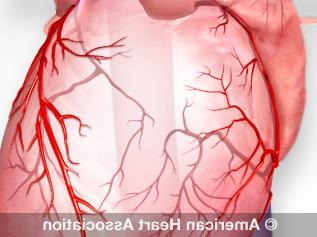冠状微血管疾病(MVD)
什么是冠状动脉微血管疾病?
Coronary microvascular disease (sometimes called small artery disease or small vessel disease) is heart disease that affects the walls 和 inner lining of tiny coronary artery blood vessels that branch off from the larger 冠状动脉. 冠心病(CHD), 也叫冠状动脉疾病, involves plaque formation that can block blood flow to the heart muscle. 冠状动脉MVD, 心脏的冠状动脉血管没有斑块, but damage to the inner walls of the blood vessels can lead to spasms 和 decrease blood flow to the heart muscle. 除了, abnormalities in smaller arteries that branch off of the main 冠状动脉 may also contribute to coronary MVD.
Women more frequently develop coronary microvascular disease 和 it occurs particularly in younger women. The risk factors for coronary MVD are the same as for coronary artery disease, including 糖尿病, 高血压 和 高胆固醇.
诊断冠状动脉MVD以前是一个挑战. PET scans 和 other types of imaging are now available which measure blood flow through the 冠状动脉 和 can detect coronary MVD in very small blood vessels.
根据国家心脏,肺和血液研究所的 WISE-R研究(链接在新窗口中打开) (女性缺血综合征评估), research is ongoing to learn more about the role of hormones in heart disease 和 to find better ways to diagnose coronary MVD.
冠状动脉微血管疾病的其他名称
- 心脏综合征X
- 非阻塞性冠心病
什么导致冠状动脉微血管疾病?
许多研究人员认为一些风险因素导致 动脉粥样硬化 也可能导致冠状动脉MVD. Atherosclerosis is a disease in which plaque builds up inside the arteries.
动脉粥样硬化的危险因素包括:
了解患冠状动脉微血管疾病的风险
Women may be at risk for coronary MVD if they have lower than normal estrogen levels at any point in their adult lives. 雌激素水平低 更年期 can raise younger women's risk for coronary MVD 和 can be caused by 压力 卵巢功能也有问题.
绝经前有高血压的女性, 尤其是收缩压高, 患冠状动脉心血管疾病的风险增加. Women who experience intense or irregular 更年期 symptoms also may be more likely to develop heart issues. 绝经期后, women tend to have more of the traditional risk factors for 动脉粥样硬化, 这也可能使他们患冠状动脉心血管疾病的风险更高.
People who have heart disease are more likely to have a worse outcome, such as a 心脏病,如果他们也有贫血. This is because anemia is thought to slow the growth of cells needed to repair damaged blood vessels.
What are the signs 和 symptoms of coronary microvascular disease?
患有冠状动脉MVD的女性通常有 胸部疼痛 叫心绞痛,也叫 微血管心绞痛. They may experience prolonged angina, 和 may also have angina when at rest.
冠状动脉MVD的其他体征和症状有:
- 呼吸急促(气促)
- 睡眠问题
- 乏力
- 精力不足
People who experience coronary MVD symptoms often first notice them during their routine daily activities 和 times of mental 压力. 它们在体力活动或劳累时较少发生. This differs from disease of the major 冠状动脉 和 main branches, 症状通常在身体活动时首次出现. 如果你有冠状动脉MVD,学习 心脏病发作的警告信号 和 女性心脏病发作的警告信号.
冠状动脉微血管疾病的诊断
Your doctor or other health care professional will diagnose coronary MVD based on your medical history, 体检和检查结果. You will also be evaluated for any risk factors for heart disease including 高胆固醇, 代谢综合征, 糖尿病和超重或肥胖.
诊断测试
The risk factors for coronary MVD 和 traditional heart disease often are the same. 一些推荐的心脏病检查包括:
冠心病的标准测试可能无法检测冠状动脉MVD. 这些检查寻找大冠状动脉的阻塞. 冠状动脉MVD影响微小的冠状动脉. If you have angina but tests show your 冠状动脉 are normal, 你还是有可能有冠状动脉内血管病. 额外的检查可以确认诊断.
Coronary MVD symptoms often first occur during routine daily tasks. Because of this, you may be asked to fill out a questionnaire called the 杜克大学活动状态指数. The DASI includes questions about how well you're able to do daily activities, 比如购物, 做饭和上班.
The DASI results can help determine what additional tests are needed to make the diagnosis of coronary MVD.
杜克大学活动状态指数
The Duke Activity Status Index is a self-administered questionnaire that measures a person's functional capacity. 它可以用来粗略估计峰值摄氧量.
- Can you take care of yourself (eating, dressing, bathing or using the toilet)?
- 你能在室内散步吗,比如在你的房子周围?
- 你能在平地上走一两个街区吗?
- 你能爬一段楼梯或爬一座山吗?
- 你能跑短距离吗?
- Can you do light work around the house, such as dusting or washing dishes?
- 你能在家里做适度的家务吗, 比如吸尘, 扫地或搬运杂货?
- 你能做家务吗, 比如擦洗地板或搬运沉重的家具?
- Can you do yard work, such as raking leaves, weeding or pushing a power mower?
- 你能发生性关系吗?
- 你能参加适度的娱乐活动吗, 比如高尔夫, 打保龄球, 跳舞, 打双打网球或打棒球或踢足球?
- 你能参加剧烈运动吗, 比如游泳, 网球单打, 足球, 篮球或滑雪?
杜克大学活动状态指数 = sum of “Yes” replies ___________
VO2峰值= (0).43 x DASI) + 9.6
VO2峰值= ___________ ml/kg/min ÷ 3.5ml /kg/min = __________ METS
你也可以做贫血测试. Anemia is thought to slow the growth of cells needed to repair damaged blood vessels.
Research to identify better ways to detect 和 diagnose coronary MVD is ongoing.
冠状动脉微血管疾病的治疗
缓解疼痛是治疗冠状动脉MVD的主要目标之一. Treatments also are used to control risk factors 和 other symptoms.
治疗方法可能包括以下药物:
- 胆固醇药物 提高胆固醇水平.
- 降压药 降低高血压,减少心脏负荷.
- 抗血小板药物 帮助防止血栓.
- 药物 to relax blood vessels including beta blockers, calcium channel blockers 和 nitroglycerin.
- 硝酸甘油治疗胸痛.
预防冠状动脉微血管疾病
目前还没有关于如何预防冠状动脉MVD的研究. Researchers don't yet know how or in what way preventing coronary MVD differs from preventing heart disease.
了解自己的家族心脏病史, making the following lifestyle changes 和 ongoing care can help you lower your risk for heart disease.
- 控制血压
- 控制胆固醇
- 降低血糖
- 得到积极的
- 吃得更好
- 减肥或控制体重
- 停止吸烟
If lifestyle changes aren't enough, your doctor may prescribe medicines to control your risk factors. 按规定服用所有的药物.






